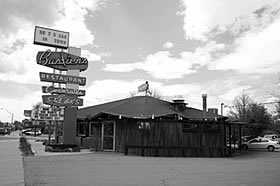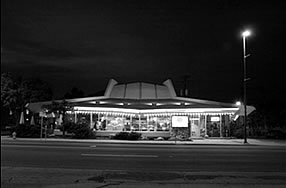
Googie
Car-oriented restaurant architecture that developed in California, especially in Los Angeles after World War I, served as the forerunner of the Googie style, also called Doo Wop or Coffee Shop Modern. Simple roadside drive-in stands evolved into more complex facilities designed to attract and serve large numbers of car-driving customers.
As construction resumed after World War II, Americans embraced modern design, new products and technologies, and an optimistic attitude about the future. A new type of freestanding building that featured indoor customer seating at counters and tables, often in addition to drive-up service, emerged. The new restaurants lured diners with their casual atmospheres, attractive prices, fast and friendly service, and menus offering a range of familiar food.
This architecture incorporated bright colors, dramatic forms, neon lights, and contrasting materials. Ample parking lots encouraged patrons to leave their cars and enter the well-illuminated restaurants. Douglas Haskell, writing in the February 1952 issue of House & Home, first coined the term “Googie” for the new architecture, a label derived from architect John Lautner’s 1949 design for a coffee house of that name in Los Angeles. Lautner, a pioneer of modern coffee shop architecture who apprenticed with Frank Lloyd Wright at Taliesin, employed elements that became basics of Googie style design, including distinctive roof lines, integrated sign pylons, little distinction between indoors and out, and the many contrasting modern materials.
Common elements:
- dramatic roof forms, including folded plate and butterfly
- multiple contrasting modern materials
- neon lights
- bright colors
- tall neon signs or integrated sign pylon
- large plate glass windows
- blurring of distinction between inside and outside parking area
Information Sources
Simmons, Tom and Laurie Simmons (Front Range Research Associates, Inc.) Bastien’s Restaurant, National Register of Historic Places nomination form, May 2009.


